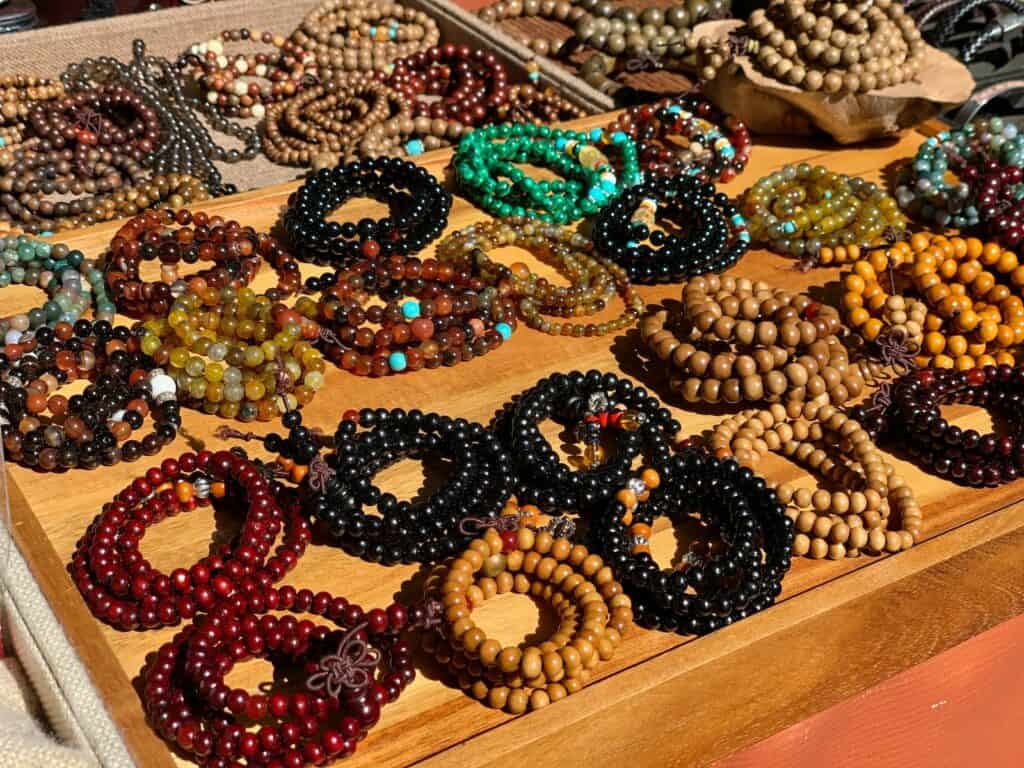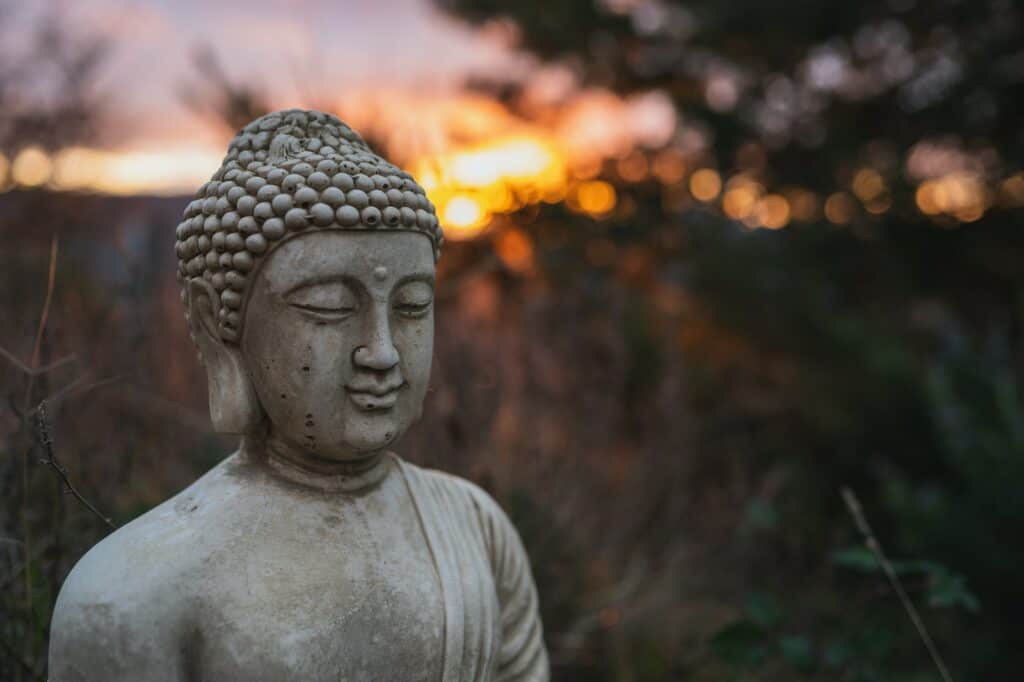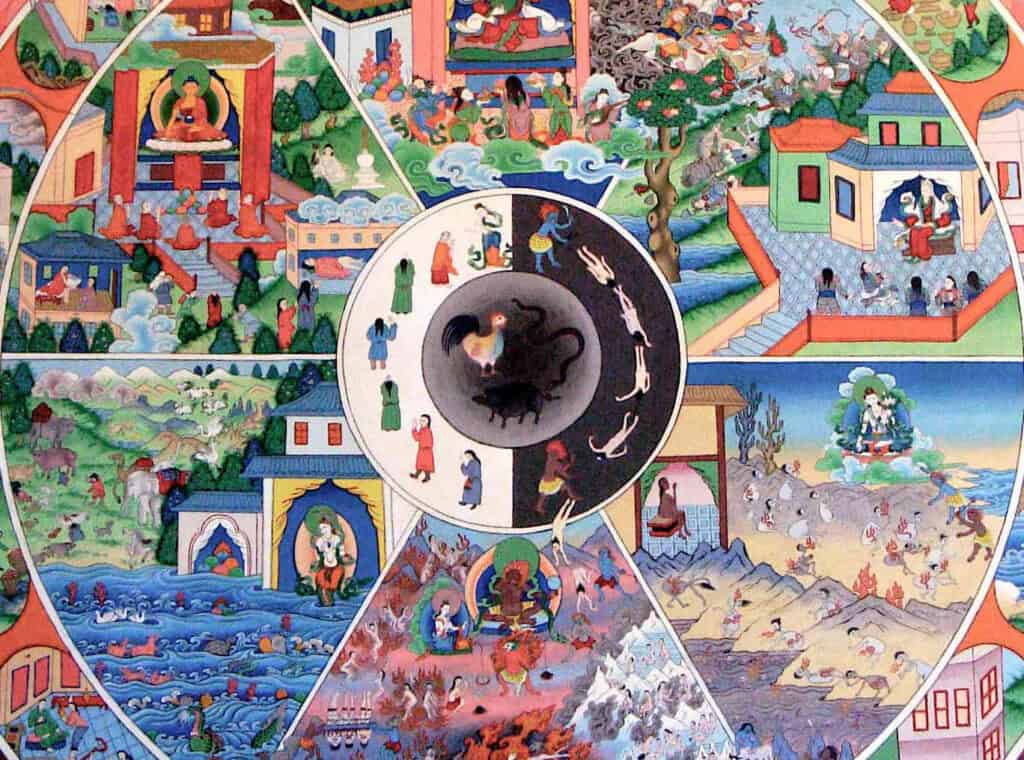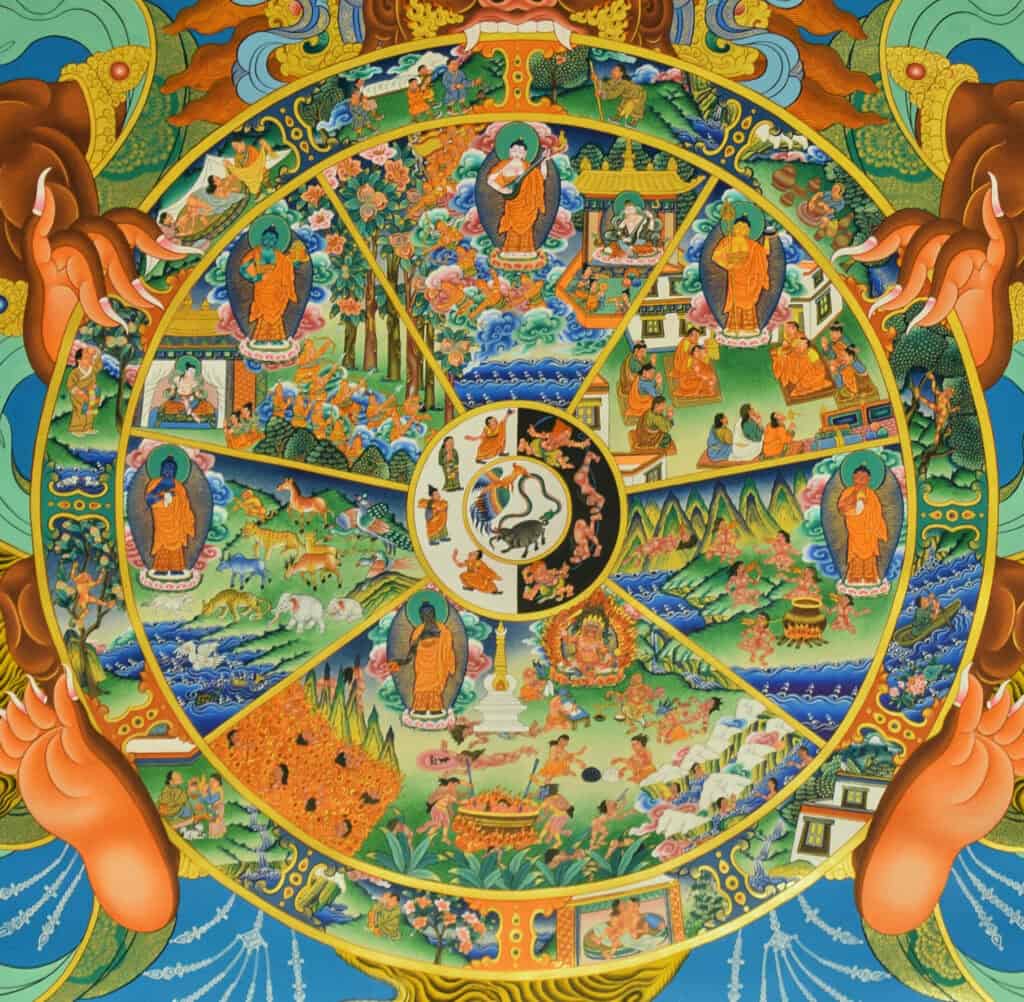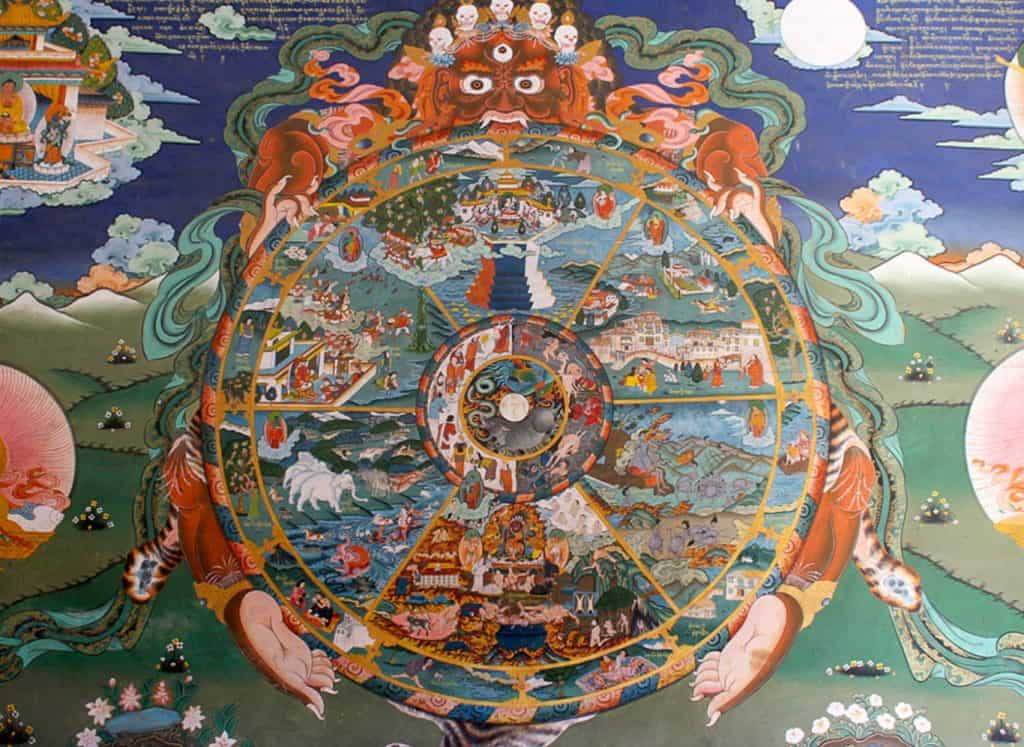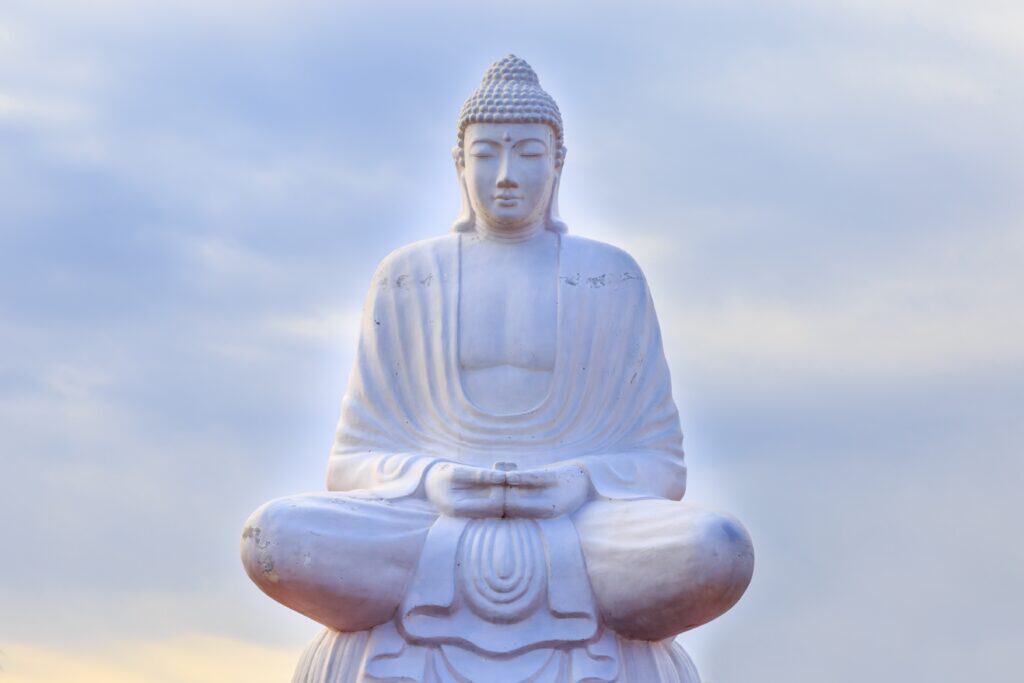Buddhist prayer beads, referred to as malas, are a traditional tool used in meditation and prayer. Often likened to a rosary, malas are a string of beads used to count mantras in sets of 108 repetitions. Malas have long been used to calm the mind and connect with the spiritual world.
As the saying goes, “a mala a day keeps the worries away.” Malas are often used as a physical reminder of a person’s spiritual journey and connection with the divine. This article will explore Buddhist prayer beads’ history, significance, and use in various contexts.
Origins of Buddhist Prayer Beads
Buddhist prayer beads, also known as malas, have spiritual roots that extend centuries back. Mala beads are believed to be used as a tool to help keep count of the number of mantras a practitioner can recite during a meditation session.
The materials used for making these beads vary, depending on the region’s cultural influences. Beads are usually made from wood, seeds, or gemstones; each material is believed to have associated healing energies.
Modern practices of using Buddhist prayer beads involve sacred rituals and spiritual symbolism. Practitioners often use the beads to say mantras, but the beads can also be used to count breaths or body movements during meditation. Users often create their own unique beads and use different colors to represent different intentions and goals. Depending on the intention, practitioners may anoint the beads with essential oils or even add a special charm or pendant to their mala.
Buddhist prayer beads provide a powerful tool for meditation and for connecting with one’s spiritual journey. Whether used for chanting mantras, counting breaths, or as a symbol of one’s goals and intentions, malas offer spiritual and emotional support. It is a reminder of our inner power to find peace and clarity and our connection to something greater.
Types of Buddhist Malas
Popular types of malas include the Japa Mala, the Mani Mala, and the Bodhi Mala, each of which are said to contain different spiritual properties. The choice of beads to use in a mala is an important factor in determining the spiritual focus of the mala and can vary based on the type of mala and its purpose.
Common materials used in mala beads include sandalwood, rudraksha, crystal, coral, lotus seeds, and more. Knotting techniques are important in connecting the beads and can also affect the spiritual properties of the mala. Additionally, each type of bead contains its own symbolism, which can also influence the spiritual focus of the mala.
Mala sizes vary greatly, from wrist mala length to full mala length, and can be either handmade or machine-made. Handmade malas often take longer to create and can be more expensive than machine-made malas. The act of chanting mantras while holding the mala is an important part of Buddhist prayer and can help to bring forth spiritual healing.
Regardless of the type of mala used, it is important to remember that the beads themselves are only symbolic. The most important part is the energy that comes from within, along with the personal connection to the mala.
The Significance of the Number 108
The sacred number 108 is often used to represent spiritual completeness and is found in many traditions around the world, symbolizing an unbroken connection to the divine.
In Buddhism, the number 108 is seen as a particularly sacred number and is used in many Buddhist practices. Malas, or Buddhist prayer beads, often consist of 108 beads. This reminds the practitioner of the 108 Buddhist virtues and symbolizes the path to enlightenment.
The number 108 also appears in Japa meditation, which is a type of meditation that uses a mala of 108 beads. During Japa meditation, practitioners recite a mantra for each bead, repeating it 108 times.
The symbolism of the number 108 is also found in the materials of Buddhist malas. Bodhi seeds, for example, are often used to make mala beads, and the number of seeds is usually 108. Murti beads are also used to make malas, and murtis are believed to have 108 special powers and qualities. These materials are used to make malas to bring a sense of connection and understanding to the prayer technique.
Mala beads have been used by monks and laypeople for centuries, and today are still a popular way for Buddhists to connect with their spiritual beliefs.
How to Select a Mala
When thinking about the mala’s design, the beads’ style and materials should be considered. Malas can be made from a variety of materials, such as wood, crystal, bone, and semi-precious stones. Each of these materials has a different spiritual purpose and vibration. The design of the mala should also be considered, as it will reflect the spiritual goals of the person wearing it.
When wearing the mala, it should be done with intention and care. It should be used as a reflection tool and to connect to one’s spiritual practice. The mala should be treated with respect and kept in a clean and safe place when not worn. Choosing the right mala can be a powerful tool in connecting to one’s spiritual practice.
When selecting a mala, it is important to consider the spiritual purpose, design, materials, and intention.
How to Use a Mala
Using a mala can be a powerful way to open your heart and soul to your spiritual practice and deepen your connection to the divine. Malas, also known as Buddhist prayer beads, are traditionally used in meditation techniques, cultural practices, and spiritual rituals. Each bead has a symbolic meaning and is believed to carry healing energies, depending on its material.
The most common mala is made of 108 beads, either strung together on a cord or threaded onto a silk thread. This number is significant in many religions and cultures, and its symbolism represents the path to enlightenment. At the end of the mala is either a tassel or a larger bead, which is known as the guru bead. Malas can be made of a variety of materials, such as sandalwood, rosewood, rudraksha seeds, and crystals, each of which is believed to have its own healing properties.
Mala practices can be used to strengthen one’s relationship with their own spiritual practice. Traditionally, mala beads are used for chanting mantras, and they are often worn as a healing reminder of the wearer’s intention or spiritual connection. By repeating a mantra with each bead, the mala helps the practitioner focus on the present moment and facilitates a deeper meditation and spiritual connection.
| Meditation Techniques | Cultural Practices | Mala Practices |
|---|---|---|
| Focus on the present | Symbolism of 108 | Chant mantras |
| Spiritual connection | Path to enlightenment | Wear as healing reminder |
| Deeper meditation | Variety of materials | Strengthen spiritual connection |
Benefits of Using Buddhist Prayer Beads
Gripping a set of Buddhist prayer beads can be a powerful way to tap into your faith and devotion, providing a connection to the divine that can be felt in every fiber of your being. Using Buddhist prayer beads can bring numerous benefits to those who practice regularly. The ritual of reciting mantras and prayers while focusing on the beads can bring a sense of peace and connection to one’s spiritual journey. Additionally, Buddhist prayer beads can be used to help cultivate meditation practices, seek spiritual guidance, and bring physical healing, mental clarity, emotional balance, and other positive effects.
In particular, the act of focusing on the beads while praying can be a powerful form of mindful living, allowing practitioners to shift their attention away from the worries of everyday life and into a more prayerful devotion. Buddhist prayer beads can also cultivate wisdom and self-reflection, making it easier to recognize the source of negative emotions and move through them with greater ease.
The benefits of using Buddhist prayer beads are far-reaching and can help practitioners to bring greater balance and harmony into their lives. From physical healing to emotional balance, prayerful devotion to wisdom cultivation, Buddhist prayer beads can be a powerful tool for tapping into the divine and living more consciously.
The Significance of Color
Each color on the Buddhist prayer beads has a different sacred symbolism and energetic vibration. The colors used in the beads can be used to ground oneself in spiritual energies and to bring about a greater sense of understanding in the practice of meditation. Through the symbolic representation of the colors, the beads can help to bring about a deeper understanding of the spiritual meaning behind the practice.
The power colors of the Buddhist prayer beads are said to bring about healing energies to those that use them. Each color is believed to have a unique energetic vibration that can bring the user a greater sense of understanding and peace. From the white of purity and innocence to the red of passion and love, the colors of the beads can be used to aid in the process of altitude meditation.
The Buddhist prayer beads offer an opportunity to bring a greater sense of understanding and peace to the practice of meditation. By using the colors on the beads to bring about a deeper understanding of the spiritual meaning behind the practice, one can gain insight and clarity into the power of prayerful devotion. Through the sacred symbolism and energetic vibrations of the colors, the beads can be used to bring about a greater sense of grounding and peace.
Mantras for Buddhist Prayer Beads
Gently gripping your Buddhist prayer beads, recite the mantras to bring peace and comfort to your spiritual journey. Mantras are a form of meditation technique often used in religious practices and prayer rituals that can help strengthen one’s spiritual connection to the divine.
Chanting mantras is a great way to focus the mind while also gaining spiritual guidance and understanding. There are many meanings behind the mantras used for Buddhist prayer beads, which can help explain karma’s effects.
Many of the mantras used for Buddhist prayer beads have roots in the Sanskrit language, with some even being derived from ancient texts. It is believed that when chanted with an open heart, the mantras can help purify one’s soul and release negative energy. Reciting mantras is a way to bring awareness to the present moment and be mindful of one’s thoughts, feelings, and actions.
Through the practice of chanting mantras with Buddhist prayer beads, one can gain a better understanding of the connectedness of all things. This sense of unity and oneness can help to bring a sense of peace and contentment. While mantras can be a powerful tool for spiritual growth, it is important to remember that they should always be used with respect and humility.
Cleaning and Storing Your Mala
To care for your mala and ensure its longevity, it is important to regularly clean and store it properly. Cleaning materials such as palo santo, sage, and sandalwood incense are often used in prayer rituals and meditation practices that are associated with malas. This is because these materials are believed to spiritually cleanse the mala, thus allowing its user to benefit from its spiritual meanings. Regular cleaning of the mala is also necessary to maintain its design, especially if it is a handmade mala.
Chanting mantras or using the mala for chanting during meditation is an important part of many spiritual practices. Therefore, it is important to keep the mala clean in order to maintain its spiritual integrity. Moreover, storing the mala in a dry and safe place when it is not in use is essential. This will help keep the mala away from dust, dirt, and other potential hazards.
The spiritual meanings of the mala should be respected at all times. This means that when cleaning and storing the mala, it should be done with care and mindfulness. Treating the mala respectfully will help honor its spiritual purpose and ensure its longevity.
Use of the Mala in Vajrayana Buddhism
In Vajrayana, also known as Tantric Buddhism, the use of mālās has specific significance. This practice, known for its complex rituals and esoteric nature, places emphasis on mantra recitation and meditation as means of attaining enlightenment. Here’s how mālās are used in this context:
- Counting Mantras: Mālās are primarily used to keep count of mantra repetitions. Each bead represents a single recitation of a mantra. The traditional mālā has 108 beads, which allows practitioners to count up to 108 mantras or divide into sections of 27 or 54 for shorter practices. This helps to keep the mind focused and disciplined during meditation, allowing the practitioner to immerse themselves in the rhythmic repetition of the mantra.
- Symbolism: In Vajrayana, the 108 beads of the mālā carry profound symbolism. They can represent the 108 defilements or afflictions (kleshas) that practitioners aim to overcome. These include various forms of ignorance, craving, and aversion. By reciting mantras for each bead, the practitioner is symbolically purifying these afflictions from their mindstream.
- Empowerment: Before using a mālā, it is often consecrated and empowered by a qualified guru or lama in a ritual process. This is done to infuse the mālā with spiritual power and blessings, which can assist the practitioner in their spiritual journey.
- Material Significance: The type of material from which the mālā is made also has significance in Vajrayana. Bodhi seed, rudraksha, lotus seed, bone (typically yak), semi-precious stones, and even precious metals are used. Each material has its own meaning and use. For instance, bone mālās are a reminder of impermanence.
- Mudras and Movement: The act of moving the mālā beads through one’s fingers also holds meaning in Vajrayana practice. Each bead is counted using a specific hand mudra (spiritual gesture), and the process of moving from one bead to the next is seen as a mindful, meditative action.
- Protector Mālās: Some Vajrayana practitioners use special “protector mālās” made with a larger number of beads (often 111) for specific protector deity practices. These are used similarly to standard mālās but are specifically designated for these more wrathful practices.
To sum it up, in Vajrayana, the mālā is not merely a tool for counting. It is a sacred instrument that aids in the practitioner’s journey toward enlightenment, keeping them focused, grounded, and mindful while also serving as a powerful symbol of their spiritual aspirations.
Finding a Buddhist Mala Online
If you are considering purchasing a mala online, you will find there are many different options available. When shopping online, it is important to consider the material selection, bead quality, and the sacred symbols that make up the mala. From gemstones to wooden beads and traditional symbols to modern artwork, you will be able to find a mala that speaks to you.
In addition to material selection, it is also important to consider the quality of the beads. Many malas are made with 108 beads plus one, which is known as the ‘Guru Bead.’ Each bead should be secure and not easily breakable to ensure that your mala necklace is high quality.
When searching for a mala online, it is important to be mindful of how it will be used. Whether it is for mindful meditation, mindful focus, or mindful practice, a mala can provide spiritual guidance and support as you strive for spiritual balance in your life. With so many options to choose from, selecting a mala online can be a meaningful and rewarding experience.
Frequently Asked Questions
Are Buddhist Prayer Beads associated with any particular religion?
Prayer beads are an ancient tradition associated with a variety of religions, each of which assigns its own spiritual significance to the beads. Popular beliefs about prayer beads vary widely, with some cultures using them as a symbol to ward off evil, while others use them as a tool for meditation and holistic healing. In all cases, the beads are imbued with cultural roots and varied uses, from spiritual practices to mark various milestones in life. Regardless of origin, prayer beads can be a powerful tool to invoke and honor spiritual, emotional, and physical well-being.
Is it necessary to say a mantra aloud when using Buddhist Prayer Beads?
Reciting mantras aloud is common in many meditative practices, but it’s not a requirement when using Buddhist prayer beads. In fact, silent meditation is just as beneficial. Depending on the prayer bead, material, colors, and shapes used, the beads can act as visual reminders of Buddhist philosophies and help cultivate spiritual awareness. Whether spoken or unspoken, mantras can be an important part of a spiritual journey when used in conjunction with prayer beads.
Are there any specific health benefits of using Buddhist Prayer Beads?
Using prayer beads has been shown to have multiple health benefits for people of all faiths, promoting mindfulness, increasing focus, calming emotions, and reducing stress. Not only does it aid in meditation, but it can also provide spiritual guidance and help to develop discipline and build awareness. For those looking for an alternative to traditional methods of relaxation, prayer beads can be an effective tool in promoting inner peace and connecting with a higher power.
Are there any special rituals involved in using Buddhist Prayer Beads?
Prayer beads have long been used as a tool to aid meditation and symbolize spiritual significance. With many different types of beads, intricate bead designs, and a rich gifting tradition, these special items are full of symbolic meaning. For those who use prayer beads, there are often specific techniques and rituals involved, such as meditating with the beads, that are specific to the culture and religion of the user. In addition, making the beads is often a special process, with its unique rituals and traditions, that can take years to master. Prayer beads are an important part of many cultures and religions, and their special rituals are a key part of the spiritual and symbolic experience.
Is it disrespectful to use Buddhist Prayer Beads if I’m not a Buddhist?
Using symbols, such as prayer beads, to find meaning and solace, and to gain spiritual guidance, is an age-old practice that can be found in many cultures. While it can be respectful to research and understand the rituals and mantras associated with a certain religion or culture, it is not necessary to follow a particular religion to appreciate the effects of mindful meditation. With respect and appreciation for another culture, prayer beads can be used to meditate and focus on one’s own spiritual journey without disrespecting the original meaning of the beads.
Conclusion
In conclusion, Buddhist prayer beads, or malas, are an essential tool in the spiritual journey of many Buddhists. They are a powerful way to practice meditation and can also be used to carry mantras, affirmations and prayers. Although the origins of the mala are steeped in symbolism and tradition, the beads are versatile and can be tailored to an individual’s spiritual practice and aesthetic tastes. Ultimately, the power of the mala lies in its ability to bring focus and clarity to spiritual practice, allowing practitioners to deepen their connection to a higher power. As such, the mala is an invaluable tool in the pursuit of mindfulness and peace.

